Major Updates
U.S. Department of Education Announces Regulatory Agenda; Pushes Some Rulemaking Issues to Next Federal Calendar
The Department of Education released their Spring 2022 Agenda and Regulatory Plan, providing timelines and intended regulations they will release this year, and which they will push until the next yearly cycle. The Department broke apart the recent rulemaking topics, and decided to push a number of regulations until next year. The regulations being pushed to the 2023 year include the following: gainful employment, certification procedures, financial responsibility, administrative capability and ability-to-benefit.
First, that means some issues important to the UPCEA community are those items within regulations that are expected to be released sometime this year (before November 1st, to be implemented earliest July 1 of 2023). Some of those include: Pell Grants for prisoners, 90/10 rule, and changes in ownership (which has two noteworthy changes considered during rulemaking:1 – defines online/distance education programs to count all students at programs from branch campuses, would be counted as part of the main campus enrollment for the Department; and 2 – implications for revenue sharing agreements and status as a nonprofit institution), among others. Stay tuned for the Department to issue proposed regulations on these items shortly.
Now, some of the regulations which have been pushed out for consideration next year, and if released prior to November 1, 2023, and would be implemented no sooner than July 1, 2024. Of most importance to the UPCEA community is the umbrella topic titled “Certification Procedures” (under which, the Department’s rulemaking language previously signaled licensure changes and state reciprocity changes, highlighted in our March 2022 Policy Matters newsletter):
- Regulations restricting the scope of distance education state authorization reciprocity agreements (i.e. SARA) to only apply to the limited scope of educational authorization, and as such, pushing all other legal claims of an educational nature application to the state where the student is located, rather than the state in which the institution is based.
- On licensure, the Department proposed regulations which would require the institution’s programs which lead to licensure be crafted such that they ensure the student meets all licensure requirements in the state in which the student is located when beginning that program.
All this to say, there are a lot of moving pieces and work that the Department is currently undertaking, and none of the above language we’ve seen may make its way into the proposed regulations. These items are some which you and your government affairs and compliance officers at your institution should keep an eye on and be ready to weigh in. When released, the public comment period for these regulations will be open for a minimum of 30 days. UPCEA will notify our members through our Weekly Briefing and Policy Matters newsletters when any of these comment periods open.
“‘The proposed regulations reflect the Department’s commitment to give full effect to Title IX, ensuring that no person experiences sex discrimination in education, and that school procedures for addressing complaints of sex discrimination, including sexual violence and other forms of sex-based harassment, are clear, effective, and fair to all involved,’ said Catherine E. Lhamon, Assistant Secretary for Civil Rights.
Additional information on the proposed rule, including a summary with background information and a fact sheet, is available here.
The unofficial version of the proposed rule is available here.” (US Department of Education Press Release)
Once released, the proposed regulations will be open for public comment for 60 days.
The Today’s Student Coalition is launching its inaugural cohort of Student Ambassadors to help reshape our systems of higher education to better address the needs of the modern-day student. This one-year, highly selective leadership opportunity is for outstanding student leaders who want to deepen their knowledge of federal education policy and influence change. Student Ambassadors will receive a $5,000 stipend while expanding their understanding of federal policy and using their voices to affect policy change that strengthens our systems of higher education. For more information on the program and its benefits, follow this link. Know of a student-leader that could benefit from a program like this? Submit their information in the form below by Thursday, July 7th @ 5:00PM.
Other News
- Department of Education Seeks IPEDS Reporting Changes by July 1, Including Noncredit Programs (Federal Register)
- Markup: Labor, Health and Human Services, Education, and Related Agencies (House Committee on Appropriations)
Marketing budgets and staffing have significantly increased from pre-pandemic levels
I once heard that when faced with trauma or chaos, humans consider a number of options … fight, flight (or flee) or freeze. Institutions and their leadership make similar choices when faced with economic adversity. Based on the 2022 UPCEA Marketing Survey, institutions of higher education and especially their professional, continuing and online (PCO) education units are apparently choosing to fight, as marketing budgets and staffing have significantly increased from pre-pandemic levels. Freezing for PCO units would mean keeping marketing budgets and staffing levels at par to pre-pandemic levels or waiting for traditional learners to return. This would also mean maintaining the same product or service and using similar processes in place pre-pandemic. Flight or fleeing for an institution of higher education or a PCO unit would mean a ceasing of operations or a merger with another institution or department.
Institutions and their PCO units appear to be choosing “fight” as their option, as they are investing in enrollment generating activities, as opposed to business-as-usual approaches. Evidence of this can be found in the 2021-2022 UPCEA Marketing Survey of 153 institutions. The survey shows that professional, continuing and online education units are devoting more resources to marketing. The average marketing budget is now 8.8% of gross revenues compared to 5.1% in 2020. One explanation of this could be that institutions are eager and concerned about lost revenue and enrollments due in part to the impending demographic cliff and increased competition, as well as disengaged or disenfranchised students to higher education. Another explanation could also be that PCO units are now marketing a more expansive portfolio that not only includes staples such as fully online graduate degrees, but also online baccalaureate programs, credit and noncredit certificates and other alternative credentials.
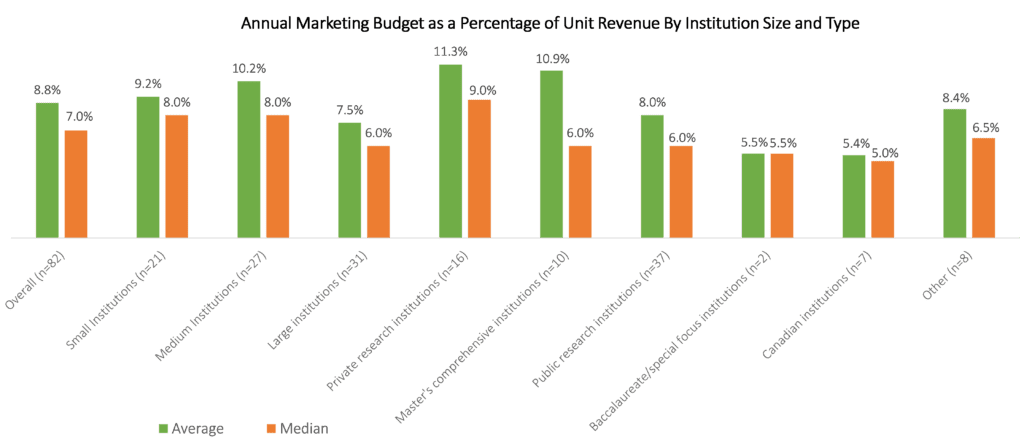
Units are spending 43% of their marketing budget on media, 25% on staffing and 20% on outsourced services. The average marketing department employs 6.88 full-time equivalent (FTE) marketing staff or using the median, as opposed to the average, 5.25 FTE marketers. This is a significant increase since 2020, up 1.4 FTEs on average during this timeframe. The increase may signify a desire to more aggressively enter a potentially more competitive, post-pandemic marketplace and/or to address changes to an institution’s portfolio, such as with a greater emphasis on alternative credentials.
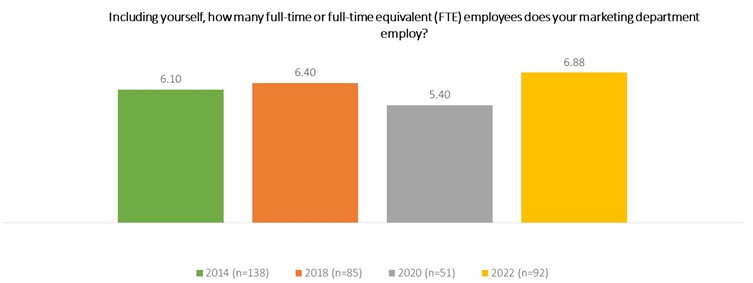
It would appear that a lot is at stake and that institutions overall appear to be choosing to fight, relying heavily on their PCO units to reach lost or disenfranchised traditional students, traditional students seeking convenience, busy professionals seeking fully online degree programs, and skill seekers and career enhancers seeking shorter training or microcredentialing options. As part of this process, PCO units will need to address other issues and not just “throw money at it.” They will need to redesign and evaluate processes to be more user-centric and better strategize their enrollment management process to convert inquiries at the highest level possible. They will also need to address marketing organizational structure and talent acquisition, as well as retention, as marketers will be highly sought-after post-pandemic. These marketers may also benefit from increased salary and flexible work benefits, as the profession is well-suited for remote work situations.
Not everyone agrees about what Web 3.0 will be, let alone how it will impact higher education, but the time to begin preparing is now.
It’s not at all surprising that a definitive vision for the future internet has not yet been shared, because there is no agreement on what the next iteration of the internet will look like. It does not yet exist, even in a single sandbox model. There is general agreement about some of the basics—decentralized with a blockchain backbone, immersive and hosting one or more metaverses. Even the name is uncertain—is it Web3 or Web 3.0 (there are nuanced differences between the two visions)?
Yet it is hugely important for the future of higher education to prepare for, and lead, in creating the new platform. Many will agree that by 2024 or 2025 the construction of experimental models of the “new” internet will be well underway. It is likely to be in a robust, stable state by the end of the decade. By that time, most websites will have faded into history. The log-ins and authentications for most every site will be long gone. Websites, as we know them now, will also be gone. Artificial intelligence (AI), virtual reality (VR), augmented reality (AR), mixed reality (XR), nonfungible tokens (NFTs) and decentralized autonomous organizations (DAOs) will run on a blockchain backbone that will enable privacy, security, smart contracts and a host of relationships that are not possible today. Users will be immersed in the internet through their avatars that will interact with avatars of other people and AI personae in a wide variety of ways.
Mason Nystrom, research analyst at Messari, shares a glimpse of the next generation of the internet:
It will involve all of the existing protocols and services we see on today’s internet, but they’ll be built on permissionless blockchains with open protocols and open standards. This will allow for a much greater level of freedom, decentralization, and democracy for individual users, content creators, and projects.
That’s a lot of change to come in the decade of the 2020s! So, we need to prepare for the wide variety of elements that will come together as we progress through this decade.
First steps may be to create a working group that includes stakeholders, both internal and external, to track technological developments and identify areas of opportunity for the university. We need to consider where we may lead in developing Web 3.0. Perhaps there are civic implications for using immersive technologies to link the university with the public at large to facilitate policy formulation and implementation. Can the institution develop smart contracts that will be executed through blockchain to strengthen the connections to segments of business and industry that match institutional strengths for just-in-time professional development offerings? Are there collaborative opportunities to utilize the secure structure for joint research projects for real-time sharing of personnel and facilities around the world?
Now is the time to begin integrating VR, AR and XR into classes both on campus and through the web. With the advent of 5G wireless, Starlink and 10G cable, a rapidly increasing percentage of users have low-latency, high-bandwidth connections that will support immersive environments at a distance. It may take years to develop these virtual services across the curriculum, so we need to begin now. Smart virtual science labs will provide cost-effective, upgradable enhancements to the physical labs on campus. The technologies will enable linking students virtually to the inner workings of business and industry for internships and career development.
We must create institutional policies and practices for generating NFTs that will become the coin of the realm in innovation through Web 3.0. It’s not too early for the university to create NFTs to stake out concepts, practices, innovations and more that may even be monetized over time. Creating a DAO with a professional association, affinity university partner or a business/enterprise could set the stage for expanding the agreements to power smart contracts of similar sorts in coming years.
Is all of this effort worthwhile? International tech expert Werner Vermaak writes,
The new internet will provide a more personal and customized browsing experience, a smarter and more human-like search assistant, and other decentralized benefits that are hoped will help to establish a more equitable web. This will be achieved by empowering each individual user to become a sovereign over their data, and creating a richer overall experience thanks to the myriad of innovations that is to come once it is in place.
The only way we will achieve these advantages is if we begin to prepare today. Who is leading the initiative on your campus to prepare and coordinate the array of innovations that will comprise Web 3.0? Are you creating DAOs and NFTs? Which departments are leveraging VR, AR and XR technologies into immersive environments? And who has reached out to partners by creating smart contracts on blockchain? Most importantly, who is coordinating these developments so the university will be prepared to take competitive advantage by leading in Web 3.0?
This article was originally published in Inside Higher Ed’s Transforming Teaching & Learning blog.
At what institution do you work, and what is your role?
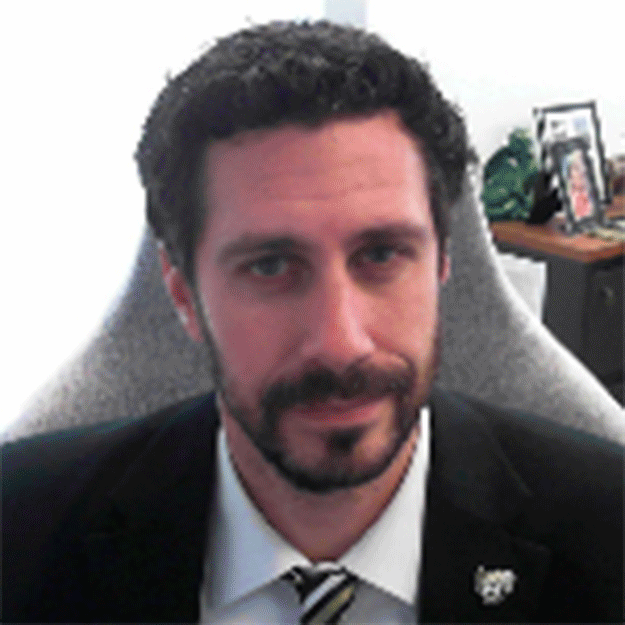 I’m the Director of e-Learning and Instructional Support (e-LIS) at Oakland University, in Michigan. I’ve been here since 2001, starting as a student employee doing help calls for our one online class at the time, then getting hired on full time in 2005, and moving into the director role in 2015. I love the university so much I never left! I get to do lots of fun things at work like help to grow online programs, do research, attend conferences, lead a great team, prank that same great team, dress up as a stormtrooper or the Joker. You know, typical work stuff. I started out doing web application development and tech support, spent years doing instructional design work and teaching workshops, ran a help desk, then eventually broke and fixed computers enough computers that they stopped having me do that sort of thing. Now I spend a lot of time in meetings and on committees, but I make sure to bring some silliness and fun to those as well. I also teach computer classes part time in the School of Business.
I’m the Director of e-Learning and Instructional Support (e-LIS) at Oakland University, in Michigan. I’ve been here since 2001, starting as a student employee doing help calls for our one online class at the time, then getting hired on full time in 2005, and moving into the director role in 2015. I love the university so much I never left! I get to do lots of fun things at work like help to grow online programs, do research, attend conferences, lead a great team, prank that same great team, dress up as a stormtrooper or the Joker. You know, typical work stuff. I started out doing web application development and tech support, spent years doing instructional design work and teaching workshops, ran a help desk, then eventually broke and fixed computers enough computers that they stopped having me do that sort of thing. Now I spend a lot of time in meetings and on committees, but I make sure to bring some silliness and fun to those as well. I also teach computer classes part time in the School of Business.
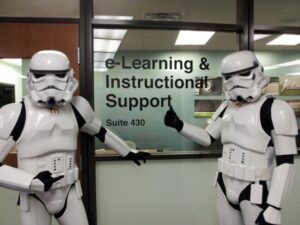
What’s your hometown?
I’ve lived in Michigan my whole life (aside from that semester I studied abroad in France). I grew up in Canton, Michigan, did most of my schooling there, but moved to New Baltimore before graduating. I now reside in Lake Orion, which isn’t too far from Oakland University’s campus. My wife and I like to think of this as our forever home, or at least until we’re 80 or 90. Our two young kids love the area, and we get to share a backyard with other families with kids so it’s like having a park right there.
What is your role in the UPCEA Online Administration Network?
I’m fairly new to the OA network, but excited to be a part of it. I’m coming from the eDesign Collaborative network, and this one is a better fit for my role. I recently volunteered to be a part of the Awards Committee, so I look forward to helping out there and seeing some of the great things my colleagues are doing.
Do you have a hidden talent?
I used to be a member of a geek rock band called Stroller Coaster. You can find some albums on Spotify. I played the bass guitar, though I don’t claim to be a musician, more of a trained monkey. I was in the band with two of my e-LIS colleagues, John Coughlin and Nic Bongers. I also love to do improv. I got to teach an improv class for the Honors College at Oakland University, and I’m now the faculty advisor for the Improv at OU student organization.
Any advice for new UPCEA members?
There is so much to love about UPCEA. The CORe forums are amazing with all of the information shared. Be sure to check them out and post your own questions or comments there. I’ve gotten invaluable information there, both from things I’ve just read myself or posts I’ve done asking for help from colleagues as we try something new or look to explore new software. And networking with colleagues at UPCEA events is always a great time. I try to get to as many in-person events as I can so I can prank, er, I mean, network with my colleagues. You can also get more involved with the different networks they have. I really enjoyed my time being a part of the eDesign Collaborative, and I’m excited for what is happening with the Online Administration network.
What are your work from home essentials?
I’ve been a gamer for a long time, so my home machine is faster and more powerful than my work machine. It also has a nicer setup. I have three monitors so I can keep important things open in different windows, helping me stay organized and up to date on what is happening when I’m working on something else. And of course I like to have some music playing when possible. My biggest “must have” is an ergonomic setup, as I’ve had carpal tunnel syndrome issues over the years. Some say it is from so many hours of computer gaming, but I say it is from attention to detail. That’s why I use the split keyboard and upright mouse. It really makes a difference when you’re at the machine the entire time.
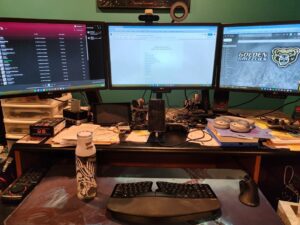
One of higher ed’s challenges is to close the loop on relevancy for every student in every module of every class.
Too often in our classes we present history, equations, assorted facts, data and retrospective analyses without supplying the current and future context of application of all of those components. The applicability of the class content in an AI-enhanced society and workplace should, in most cases, be the emphasis of the entire course. Perhaps we may think the application of the assembly of facts, principles and concepts is obvious when it is not at all clear to our learners or to employers. Examples of this course design deficiency abound across the curriculum but especially in older general education classes and textbooks. This gap in building knowledge is at the source of many criticisms and complaints about higher education. The relevancy gap becomes especially concerning as students are digging themselves into an average of $37,000 in debt without knowing how to apply whatever they may have learned in a career.
Author Lauren Hamer writes in Wall Street Watchdog that the name and focus of the degree itself can be a turnoff to employers. For example, she found the unemployment rate among environmental science degree holders was nearly 12 percent, while natural resource management degree holders averaged a 2 percent unemployment rate. Again and again, she cites examples where the degree that includes a clear application to careers is much more likely than a related generic degree to result in employment.
It is essential that we review all of our courses and degrees for relevance and applicability to lives and careers of today and tomorrow. We must consider constructing assessments not on the memorization of history, principles and facts, but rather on applying what is learned to current and future challenges. Making authentic assessments a core value in course development can go a long way toward updating the curriculum. In doing so, the course and degree titles will naturally become more descriptive and appealing to both students and employers.
While this is true for degrees, it is even more relevant in the burgeoning certificate and credentialing field. Whether they be stackable, for-credit or noncredit credentials, successful programs have a laser focus on relevance to the workforce job market. There are thousands and thousands of college-based certificate programs. Many are online to meet the needs of the widest variety of students, and many are accredited by associations and agencies in the area of study.
Certification programs are ones that prepare the learner for a specific field of employment and generally result in a credential that is broadly accepted as competence for a particular career. Not all certifications are equal. The team at Glassdoor writes, “With the rise of online learning, there’s no shortage of classes you can take that offer you a certification in a particular trade, skill or software program. But outside of positions that require certifications—pilots, emergency medical technicians and insurance agents, for example—do any of these make a real difference in a job application? We reached out to recruiters and HR professionals to get the answer. The consensus: Certifications certainly can make a difference, but not all certifications are created equal.”
Credentialing is not limited to learners in the U.S. The team at Goodwall, a leading international professional development firm, writes, “Professional job certifications are a great way to shine and show you have the right skills to succeed. Certifications are proof that an individual completed a set of training programs that focus on a specialized area of study. The number of professional certification options available is vast, some of them can even land you a great job without a degree. If you’re overwhelmed by the options, we’ve provided a list of the best job certifications to set you apart from the crowd.”
Geoff Williams at U.S. News & World Report compiled a list of 15 top-paying certifications that are attracting students and employers in 2022. “These programs, often offered by colleges, provide training in specific fields. You can take certificate programs as a college graduate, but there are many designed for people with a high school diploma or GED [who] want additional training to land an entry-level position.”
What is your university doing to assure that all offerings—credit and noncredit—are relevant to society and the workplace of today and tomorrow? Is your institution offering short-course, nondegree (or stackable within a degree) programs that are forward-designed, relevant and affordable? Who is leading the initiative? What can you do to facilitate this advance that could make a real difference in the viability of your institution today and tomorrow?
This article was originally published in Inside Higher Ed’s Transforming Teaching & Learning blog.
Historical and cultural moments that impacted the evolution of the American education system
In a new episode of the MindMaxing podcast series, “Adolescence to Adulthood,” Dr. Anthony Carnevale outlines the political, economic, and social shifts that have made obtaining a college education a necessity—and a challenge—for many students, especially those from lower-income families.
As research Professor and Director of the Georgetown University Center on Education and the Workforce, Dr. Carnevale has studied the decades-in-the-making transformation of American education and its impact on young adults seeking employment.
Years ago, high school education was enough to help a young adult land a job with a living wage. Today, college—if not a secondary degree—is a requirement.
3 Major Shifts in American Education
Between 1970 and 1983, three fundamental shifts gave way to a new approach to American education.
1. Secondary education became the gateway to a middle-class life
In the 1970s, secondary education was not the norm, nor was it necessary. It was more common for high school graduates to follow in a family member’s footsteps and take up a local job.
However, notes Dr. Carnevale, as the recession ended in 1983, secondary education gradually became “the most well-traveled pathway to the middle class.” As a result, the average American young person began taking until the age of 32 to arrive at a middle-class level—up from age 25, which was the average in the 1970s.
2. Vocational schools lost popularity and political backing
During the same period, educational policy began abandoning vocational schools. “And we did so for a good reason,” says Dr. Carnevale.
“People were being moved into occupations. . . when you looked years later, they weren’t doing any better than the people who arrived at those occupations with no prior vocational education.”
3. Social movements ended the postwar tracking system
By the 1980s, citizens also had grown disenchanted with “comprehensive high school.”
A tracking system developed after World War II by James Conant, author of The American High School Today (1959), comprehensive high school centered on the theory that only 5% of the population needed advanced education. Dr. Carnevale shares, “James Conant and the powers that be in America decided that’s all we needed to staff this new world economic and military power and to fight the communist.”
The top 5% of male students were to go to college and become the nation’s leaders. The other 95% of male students? They took up vocational education. The female students learned home economics and typing, or nothing at all.
But the Civil Rights and Women’s Liberation movements forced society to change, and by the 1980s, the American people “had enough of tracking,” notes Dr. Carnevale.
A Nation at Risk Initiates a Turning Point
In 1983, a 36-page study commissioned by President Reagan painted a bleak picture of education in the United States, deeming the country: A Nation at Risk. The study warned that unless massive policy change could reform the educational system, the United States would cease to be a world leader and global powerhouse.
In response, the new K-12 system was installed to provide every American child with a good general education, thereby ending vocational education. Along the way, secondary and post-secondary education became the new standard.
However, the strides made in American academics also forced the youth labor market to collapse. “Young people were not getting decent work experience anymore. The jobs they could get, which were much fewer and actually paid less in real dollars, didn’t have the kinds of experiences you needed to get a long-term career,” notes Dr. Carnevale.
Making It in Today’s America
Although integrating work-based learning into education is a challenge that remains today, secondary education is still required to “make it” in America.
How do Dr. Carnevale and Georgetown define “making it” in America? When a 40-year-old person earns a minimum $45,000 annual salary. Unfortunately, only 20% of 40-year-olds working jobs that require a high school diploma (and no secondary education) make at least $45,000. Many of those good “high school jobs” have historically gone to males; female students have stayed in school longer to remain competitive.
Today, we have an education system that stretches from preschool to post-secondary education, and it largely determines whether or not a person will achieve success. And as a society, we’ve adopted a belief that if you work hard and do well in school, you’ll succeed—but that thinking shows individualist biases. Dr. Carnevale notes that while “education has the ability to expand opportunity” and “solve upward mobility problems by race and class and gender,” it falls short because of economic disparity.
Of the students who have high IQs and test scores and come from the bottom quartile of the family income distribution (the lowest 25%), only 30% “make it” in America. By contrast, students from the highest quartile of family income—those in the top 25% financially—who have the lowest test scores and don’t perform well at school have a 70% chance of making it. So, states Dr. Carnevale, “it’s still true that it’s better to be rich than smart in America.”
An Integrated Approach Is the Path Forward
Knowing that extreme economic disparity exists in the American education system, it can be hard to identify possible solutions. However, Dr. Carnevale has hope for progress as the collective focus shifts to an education system that integrates experience.
“All the way from preschool to kindergarten, to grade school, to middle school, to high school, to post-secondary and then into the labor market. . . there’s a lot of emphasis now on trying to interconnect these systems,” he says.
Dr. Carnevale notes that the new approach doesn’t “track” anyone but exposes students to possible career pathways through internships and work-based learning programs. While finding the right opportunities can be challenging, there’s more demand for this type of real-world experience, as it focuses on the success of the whole human.
“The happy news,” he states, “has been that the economy wants full people. The economy, the employer, wants the whole person on the job now.”
Hiring managers want better-skilled workers with well-rounded knowledge. Dr. Carnevale states that the purpose of higher education “is that in the end, you want to be sure that everybody leaves with a future.”
The MindMaxing Podcast, hosted by MindMax Founder & CEO Lee Maxey, offers enlightening and timely interviews with higher education leaders and is available at https://mindmax.net/ideas. Since 2009, MindMax has partnered with colleges and universities to serve their programs’ strategic growth objectives through digital marketing and enrollment services.
